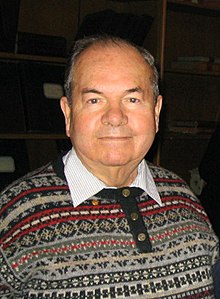അലെക്സി അബ്രിക്കൊസോവ്
അലെക്സി അലക്സിയെവിച്ച് അബ്രിക്കൊസോവ് (Russian: Алексе́й Алексе́евич Абрико́сов; June 25, 1928 - March 29, 2017) സോവിയറ്റ്, റഷ്യൻ, അമെരിക്കൻ ഭൗതികശാസ്ത്രജ്ഞൻ ആയിരുന്നു. [3]condensed matter physicsൽ ആണദ്ദേഹം തന്റെ സംഭാവനകൾ നൽകിയത്. 2003ലെ ഭൗതികശാസ്ത്രത്തിലെ നോബൽ സമ്മാനം അദ്ദേഹത്തിനു ലഭിച്ചു. [3][4][5]
Alexei Abrikosov | |
|---|---|
 | |
| ജനനം | Alexei Alexeyevich Abrikosov ജൂൺ 25, 1928 |
| പൗരത്വം |
|
| കലാലയം | |
| അറിയപ്പെടുന്നത് | |
| ജീവിതപങ്കാളി(കൾ) | Svetlana Yuriyevna Bunkova
(m. 1977) |
| കുട്ടികൾ | 3 |
| പുരസ്കാരങ്ങൾ |
|
| ശാസ്ത്രീയ ജീവിതം | |
| പ്രവർത്തനതലം | Physics |
| സ്ഥാപനങ്ങൾ | |
| വെബ്സൈറ്റ് | www |
വിദ്യാഭ്യാസവും മുൻകാലജിവിതവും
തിരുത്തുകഅബ്രിക്കൊസോവ് 1928 ജൂൺ 25നു സോവിയറ്റ് യൂണിയനിലെ റഷ്യൻ സോവിയറ്റ് ഫെഡറേഷൻ ഓഫ് സോഷ്യലിസ്റ്റ് റിപ്പബ്ലിക്കിലെ മോസ്കോയിൽ ജനിച്ചു. അദ്ദേഹത്തിന്റെ മാതാപിതാക്കൾ വൈദ്യശാസ്ത്രജ്ഞരായിരുന്ന പ്രൊഫസ്സർ അലെക്സി ഇവാനോവിച്ച് അബ്രിക്കൊസോവ്'ഉം ഡോ. ഫാനി അബ്രിക്കോസോവയും ആയിരുന്നു. 1948ൽ മോസ്കോ സർവ്വകലാശാലയിൽ നിന്നും ബിരുദം കരസ്തമാക്കി. 1948 മുതൽ 1965 വരെ അദ്ദേഹം യു. എസ്. എസ്. ആർ അക്കാദമി ഓഫ് സയൻസസിലെ Institute for Physical Problemsൽ ജോലി ചെയ്തു. അവിടെവച്ച് 1951ൽ the theory of thermal diffusion in plasmasയിൽ ഡോക്ടറേറ്റ് ലഭിച്ചു. 1955ൽ quantum electrodynamics at high energies എന്ന വിഷയത്തിൽ ഒരു ഉയർന്ന ഡോക്ടറേറ്റും ലഭിച്ചു.
ഔദ്യോഗികജീവിതം
തിരുത്തുക1965 മുതൽ 1988 വരെ അദ്ദേഹം Landau Institute for Theoretical Physics (USSR Academy of Sciences)ൽ ജോലിചെയ്തു. 1965 മുതൽ അദ്ദേഹം മോസ്കോ സ്റ്റേറ്റ് സർവ്വകലാശാലയുടെ പ്രൊഫസ്സറായിരുന്നു. ഇതിനുപുറമേ, 1972 മുതൽ 1976 വരെ Moscow Institute of Physics and Technologyയിൽ പ്രവർത്തിച്ചു. 1976 മുതൽ 1991 വരെ Moscow Institute of Steel and Alloys ലും പ്രവർത്തിച്ചു. 1987 മുതൽ 1991 വരെ USSR Academy of Sciencesന്റെ മുഴുവൻ സമയ അംഗവുമായി. 1991ൽ റഷ്യയുടെ Russian Academy of Sciencesന്റെ മുഴുവൻ സമയ അംഗമായി.
1952ലും 1957ലുമായി അബ്രിക്കൊസോവ് അതിചാലകങ്ങളുടെ ഒരു കൂട്ടത്തിൽ കാന്തിക ഫ്ലക്സ് എങ്ങനെ തുളച്ചുകയറും എന്ന് വിവരിച്ചു. ഇവയെ type-II superconductors എന്നാണ് വിളിക്കുന്നത്. ഇതിന്റെ ക്രമീകരണവരകളെ Abrikosov vortex lattice എന്നു വിളിക്കുന്നു.
1991 മുതൽ അദ്ദേഹം, അമേരിക്കയിലെ ഇല്ലിനോയിസിലെ Argonne National Laboratory യിൽ ജോലിചെയ്യുന്നു.
പുരസ്കാരങ്ങളും ബഹുമതികളും
തിരുത്തുകഅബ്രിക്കൊസോവിന് 1966ലെ ലെനിൻ പ്രൈസ് ലഭിച്ചു. 1972ൽ ഫ്രിറ്റ്സ് ലണ്ടൻ മെമ്മോറിയൽ പ്രൈസ് ലഭിച്ചു. 1982ൽ യു. എസ്. എസ്. ആർ സ്റ്റേറ്റ് പ്രൈസ് ലഭിച്ചു. 1989 ൽ Landau Prize നേടി. 2003ൽ Nobel Prize in Physics, with Vitaly Ginzburg and Anthony James Leggett. ലഭിച്ച മറ്റു പുരസ്കാരങ്ങൾ:
- യു. എസ്. എസ്. ആർ അക്കാദമി ഓഫ് സയൻസസിന്റെ അംഗം
- Lenin Prize, 1966
- Order of the Badge of Honour, 1975
- Order of the Red Banner of Labour, 1988
- USSR State Prize, 1982
- Academician of the Academy of Sciences of the USSR (now Russian Academy of Sciences) 1987
- Landau Prize, 1989
- John Bardeen Award, 1991
- Foreign Honorary Member of the American Academy of Arts and Sciences, 1991
- Member of the National Academy of Sciences, USA, 2000
- Elected a Foreign Member of the Royal Society (ForMemRS) in 2001[1]
- Nobel Prize in Physics, 2003
- Gold Medal of Vernadsky from National Academy of Sciences of Ukraine, 2015
വ്യക്തിജീവിതം
തിരുത്തുകഭാര്യ: സ്വെറ്റ്ലാന യൂറിയേവ്ന ബുൺകോവ. അബ്രിക്കൊസോവിനു 3 മക്കൾ
അവലംബം
തിരുത്തുക- ↑ 1.0 1.1 "Fellows of the Royal Society". London: Royal Society. Archived from the original on 2015-03-16.
- ↑ "Alexei A. Abrikosov, Argonne National Laboratory". National Academy of Sciences. Archived from the original on 2015-08-19.
- ↑ 3.0 3.1 Alexei A. Abrikosov. Autobiography. Nobelprize.org, the official website of the Nobel Prize, 2003
- ↑ Abrikosov Biography and Bibliographic Resources, from the Office of Scientific and Technical Information, United States Department of Energy
- ↑ A Short Biography of Abrikosov Archived 2016-03-03 at the Wayback Machine., on the website of the Material Science Division of Argonne National Laboratory
- ↑ "Book of Members, 1780–2010: Chapter A" (PDF). American Academy of Arts and Sciences. Retrieved 20 March 2011.